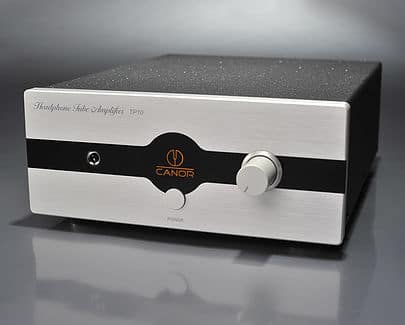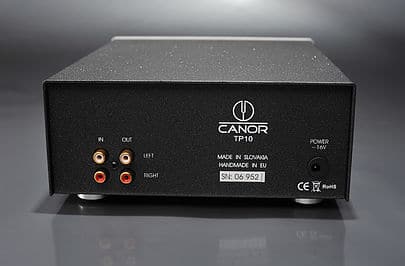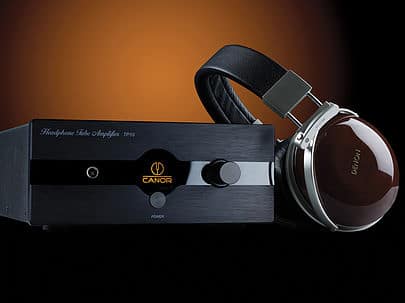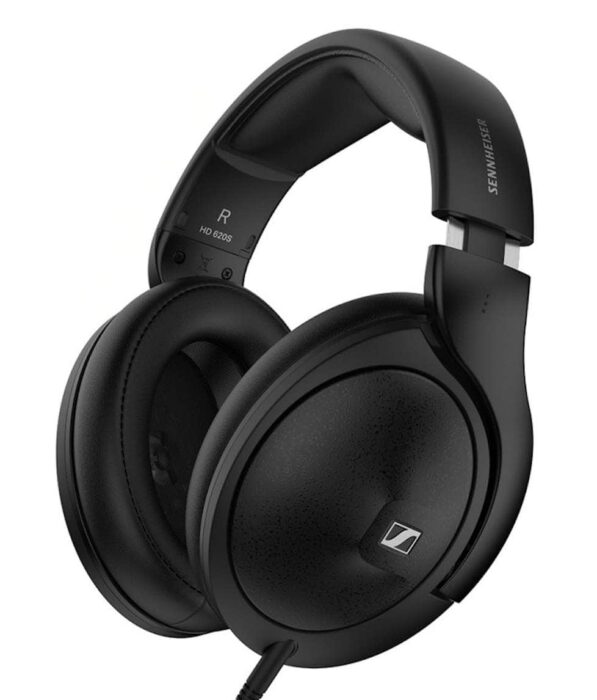The Article
Canor TP-10 headphone amplifier
3rd November 2015

Paul Rigby reviews Canor’s TP-10 headphone amplifier
The popularity of headphones as a genre seems to continue unabated and is reflected in the continuing appearance of hardware devoted to the genre. Canor is a prime example of how the hi-fi industry is establishing a reinvigorated headphone lineage by refining and improving upon its established SH-1 headphone amplifier. Although, for the designer, Zdenek Brezovjak, the impetus for the TP-10 was initially more self-serving, “I wanted to listen to music so that I would not disturb the people around me. In the evenings, when I would work on designs on the computer, I wanted the freedom to listen to music of good quality. That’s when the idea to make our own headamp struck me.”
Improvements to the initial SH-1 design are many and begin in the power supply, although the 16V, 1A transformer in the form of a wall wart found as part of the TP-10 package is apparently not one of them. We have to look inside the chassis for that, “The circuit that creates the anode voltage has been improved,” said the designer, Zdenek Brezovjak. “Also, we retained the wall wart to distance the transformer from the PCB components to avoid electromagnetic interference.”
At this price, however, I would have appreciated a more robust approach to power than the wall wart attached by a bell wire connector. Failing that, an upgrade option would have been welcome.
The core of the improvements, however, revolves round the PCB and how it is treated during construction, “We approach all the solutions as precise as we can, and we always strive to get ‘blood from a stone’ from a given solution,” commented Brezovjak. Known as CMT (Canor PCB Milling Technology), each PCB is milled to improve the dielectric of the board itself, “Within a hard-wired circuit board, you can use high quality cabling which can feature an efficient ‘air’ dielectric to improve sound quality.
This is fine but the use of hard wiring on a circuit board has limits in terms of precision of the layout. You end up with spaghetti wiring all over the place with no consistency and lots of stray electromagnetic fields hanging around. CMT removes part of the PCB itself to reduce the dielectric coefficient of the circuit board. Doing it this way improves the accuracy and consistency of placement while approaching direct wired, low resistance and dielectric-coefficient audio cable.”
Other improvements to the TP-10 include packing Burr-Brown Op-amps and polypropylene capacitors into the chassis. The TP10 is a hybrid design and, for the valve element, the new design includes a 12AT7 input tube instead of the SH-1’s 12AX7, “The hybrid design originated as a trade-off between sound quality and price. If we wanted to manufacture an all-valve system and have the option to connect low impedance headphones, the price would have trebled,” said Brezovjak.
Canor takes the valve element of the TP-10 very seriously. In fact, the valves are extensively tested by the company’s own Aladdin II system and then burned in by another in-house system, the BT-2.
The TP-10 arrived in a silver and black chassis that rings like a bell — most disconcerting. Again, for the price, I would have expected something a little more acoustically neutral. As it is, that chassis weighs in at 3kg without the power supply and spans 210x88x295mm, features a volume knob and full size headphone socket on the front alongside a push button power switch while, on the rear is a pair of inputs and a pair of outputs along with a socket for the power supply.
SOUND QUALITY
Using my Sennheiser HD800 headphones plugged into an Icon HP8 Mk.II headphone amplifier as a reference and spinning the original version of Manfred Mann’s Earth Band’s ‘Tribal Statistics’ from the 1983 album, ‘Somewhere In Afrika’, the most obvious sonic change when listening to the Canor was the impact of the lower frequencies.
Bass was tight and hard. In fact, I almost felt that I had been mugged by it as soon as the track began, walloping me over the head with its powerful attack. Bass punches its way through the track, giving it forward momentum. I was surprised, however, to experience such a wide soundstage from the Canor. There is an enormous amount of space afforded to the TP-10 soundstage that helps the instrumentalists to relax into their performance. You never feel, at any time, that the band suffers from a lack of elbow room which allows the song to be delivered with an ease. This allows the ear to hear more from each instrument, providing a 3D view of the presentation.
As such, secondary rhythmic instruments, such as synths, have a more prominent role in the mix while the guitar is played with freedom and a carefree approach. The lead vocal, though, continued to be even and free flowing with a smoothness that promoted a comfortable delivery.
Changing to jazz and Ella Fitzgerald’s interpretation of Bewitched from the Speakers Corner audiophile reissue of The Rodgers and Hart Song Book, the bass was a notable part of the mix and one that, not surprisingly, is a significant change from a typical valve reference. The lower frequency extension provided a rhythmic drive to the track, adding depth and richness to the presentation.
Fitzgerald’s delivery was also particularly open and airy in its tone. The Canor’s midrange capability provided a large capacity for complex frequencies to be extended without any sign of compression or bloom. Upper mids had a particularly natural tonal aspect with piano providing a natural flow to the melody while the percussion, languid and unhurried on this track, was informative with extra detail on the brushstrokes.
Guitar meanwhile had a more significant role in the progression of the song. It seemed, in fact, that a sonic ceiling, that can often be heard on this track, giving a claustrophobia to the soundstage was, with the Canor, effectively removed allowing much more space and flow to the track. As for the soundstage itself, there was a more structured, less intimate effect that only served to give the performers room to manoeuvre.
Moving to CD and my Densen two box B-475, I inserted The Beatles’ Anthology I CD and selected Free As A Bird. Right from the off, the Canor proved to be dynamically exciting with Ringo Starr’s drum strikes being sharp, hard and characterful, confidently announcing the opening of the song. As a contrast, within the upper mids, the acoustic guitar strumming proved to be full and rich, giving the impression that it contained far more strings than it did.
In fact, midrange proved to be spacious and airy but there was also plenty of attention to detail from the TP-10. For example, Paul McCartney’s vocal solo offered appreciable etched detail which gave the delivery more emotive emphasis.
This also enabled the rhythm guitar to promote a greater melodic flow and clarity was extended to George Harrison’s electric guitar solo where each note was rounded and distinctive. Intriguingly, the minor role of the synth, there to prove a fuller sound to the rhythm section, was more noticeable and forward in the mix as was John Lennon’s final sample vocal on the outro, where has says, “Made by John Lennon” over the George Harrison ukulele (which is “Turned out nice again” when played backwards!)
Turning to Handel’s Messiah, conducted by Sir Charles Mackerras and backed by the Huddersfield Choral Society, the grand scale of the vocal on Behold the Lamb of God and Felicity Palmer’s aria, He was despised, was impressive. The soundstage provided a rich swell that was uplifting. The inherent air and space that was infused via the TP-10 added an ethereal element that gave a lightness to big, bold vocal movements. Yet, the music was grounded by the string backing from the Royal Philharmonic orchestra that tied the vocals together, adding structure and depth while upper orchestral bass provided a welcome prominence that added solidity to the arrangement.
CONCLUSION
Sometimes, hybrid solid state/valve designs can clash in their inherent philosophies or end up offering a wishy-washy aural mess but the design of the Canor TP-10 has proven to be the result of much thought and planning because this is one hybrid design that truly works. Because of the issues with the power supply and the chassis, I wonder if the potential of the TP-10 has actually been reached. For now, it offers a tight, punchy bass but set within a delicate, airy soundstage. The TP-10 successfully combines toughness and delicacy providing a big sound for, in relative terms, not very much money.
CANOR TP-10 HEADPHONE AMPLIFIER £850
Website: www.soundfowndations.co.uk
Tel: 0118 981 4238
Good: capacious midrange, tight bass response, instrumental separation & broad soundstage
Bad: ringing chassis & weedy power supply




